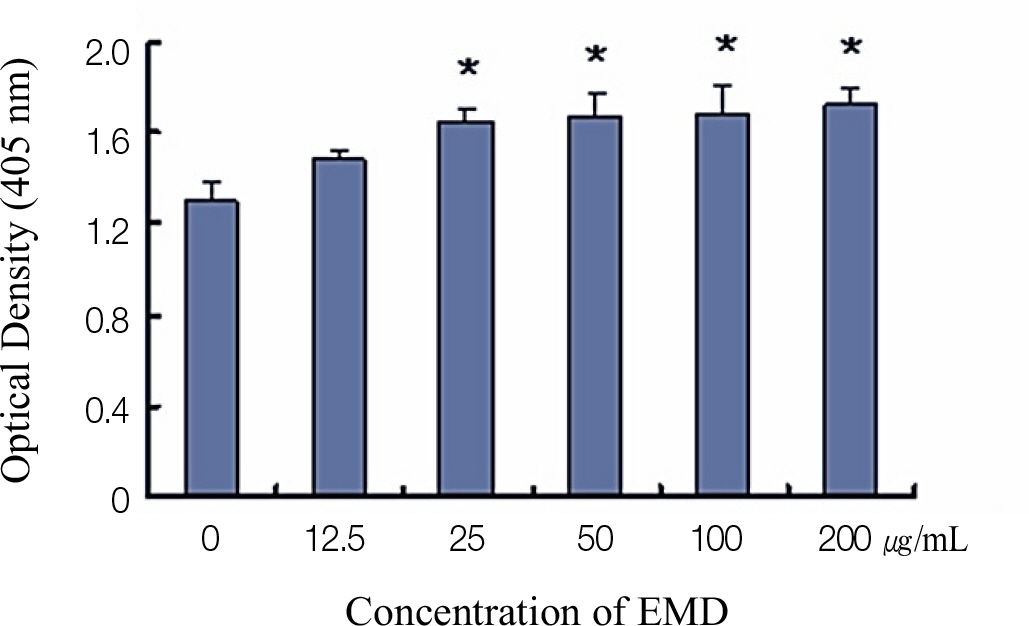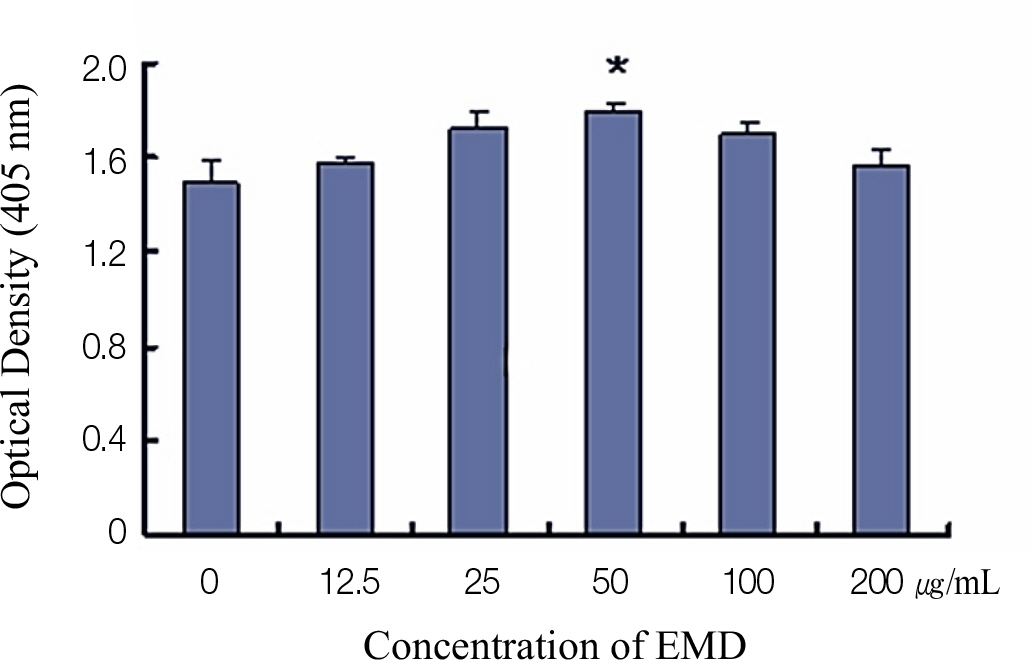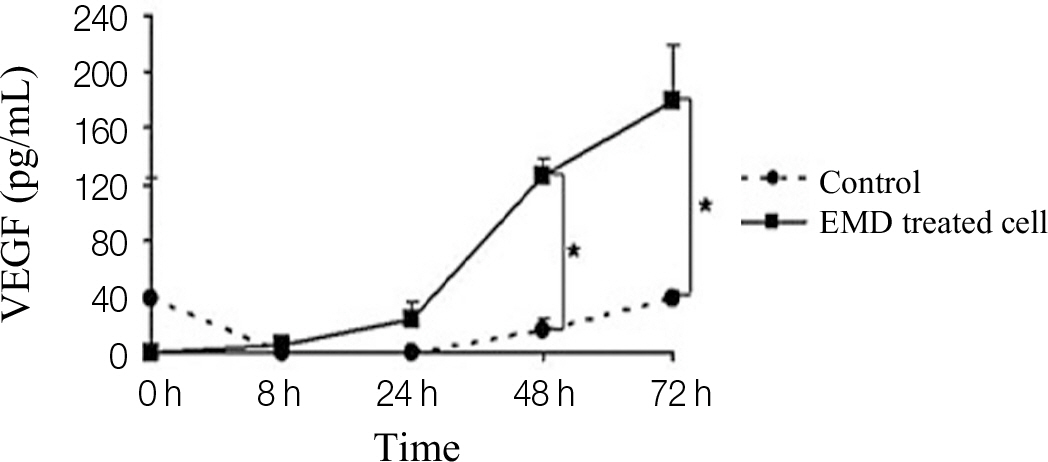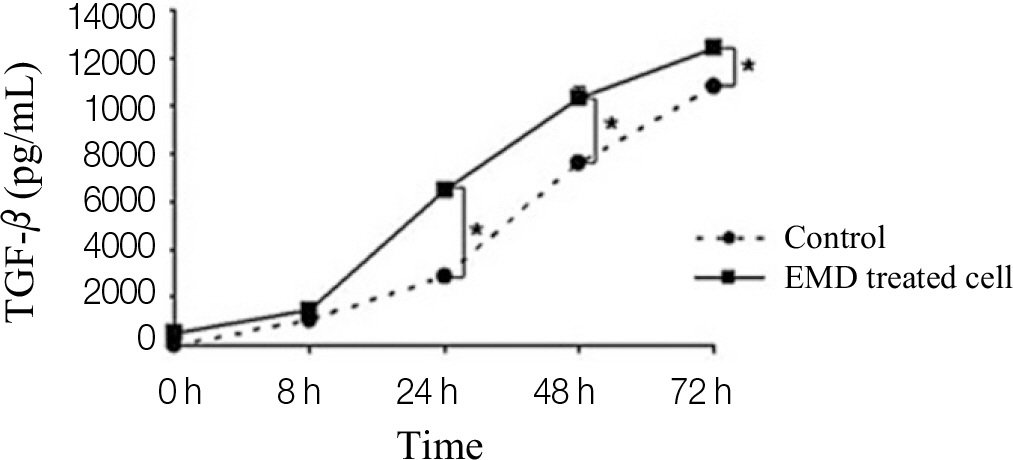J Korean Acad Prosthodont.
2016 Jul;54(3):203-209. 10.4047/jkap.2016.54.3.203.
Effects of enamel matrix derivatives on the proliferation and the release of growth factors of human periodontal ligament cells
- Affiliations
-
- 1Department of Periodontology, Korea University Anam Hospital, Seoul, Republic of Korea.
- 2Department of Periodontology, School of Medicine, Ewha Womans University, Seoul, Republic of Korea. eunkyoungpang@gmail.com
- KMID: 2344857
- DOI: http://doi.org/10.4047/jkap.2016.54.3.203
Abstract
- PURPOSE
Stimulating the proliferation and migration of periodontal ligament cells (PDLCs) has become the main goal of periodontal regeneration. To accomplish this goal, regeneration procedures have been developed, but results have not been predictable. Recently, tissue engineering using enamel matrix derivatives (EMDs) and growth factors has been applied to periodontal regeneration; however, the mechanism of EMDs is largely unknown. The aim of this study was to investigate the effects of EMDs on the proliferation and release of growth factors from PDLCs.
MATERIALS AND METHODS
Human PDLCs were removed from individually extracted 3rd molars of healthy young adults, and cultured in the media containing EMDs (Emdogain, Biora, Malmo, Sweden) at concentration of 0, 12.5, 25, 50, 100, and 200 µg/mL each. Cell proliferation and ALP (alka-line phosphatase) activity were measured. The evaluation of growth factors released by PDLCs was also performed by one-way analysis of variance (ANOVA) and Bonferroni's multiple comparison test.
RESULTS
Significantly increased proliferation and ALP activity were observed in PDLCs treated with over 25 µg/mL and 50 µg/mL EMDs, respectively. Additionally, treatment of PDLCs with 50 µg/mL resulted in significantly increased release of vascular endothelial growth factor (VEGF) and transforming growth factor (TGF)-β after 24 h and 48 h, respectively.
CONCLUSION
EMDs enhance the proliferation and ALP activity of PDLCs, and promote the release of growth factors, including VEGF and TGF-β, from PDLCs. Therefore EMDs could be one of the effective methods for periodontal regeneration.
Keyword
MeSH Terms
-
Cell Proliferation
Dental Enamel*
Humans*
Intercellular Signaling Peptides and Proteins*
Molar
Periodontal Ligament*
Regeneration
Tissue Engineering
Transforming Growth Factors
Vascular Endothelial Growth Factor A
Young Adult
Intercellular Signaling Peptides and Proteins
Transforming Growth Factors
Vascular Endothelial Growth Factor A
Figure
Reference
-
1.Hoang AM., Oates TW., Cochran DL. In vitro wound healing responses to enamel matrix derivative. J Periodontol. 2000. 71:1270–7.
Article2.Chong CH., Carnes DL., Moritz AJ., Oates T., Ryu OH., Simmer J., Cochran DL. Human periodontal fibroblast response to enamel matrix derivative, amelogenin, and platelet-derived growth factor-BB. J Periodontol. 2006. 77:1242–52.
Article3.Slavkin HC. Towards a cellular and molecular understanding of periodontics. Cementogenesis revisited. J Periodontol. 1976. 47:249–55.
Article4.Gestrelius S., Andersson C., Lidström D., Hammarström L., Somerman M. In vitro studies on periodontal ligament cells and enamel matrix derivative. J Clin Periodontol. 1997. 24:685–92.
Article5.Hammarström L. Enamel matrix, cementum development and regeneration. J Clin Periodontol. 1997. 24:658–68.
Article6.Heijl L., Heden G., Svärdström G., Ostgren A. Enamel matrix derivative (EMDOGAIN) in the treatment of intrabony periodontal defects. J Clin Periodontol. 1997. 24:705–14.
Article7.Froum SJ., Weinberg MA., Rosenberg E., Tarnow D. A comparative study utilizing open flap debridement with and without enamel matrix derivative in the treatment of periodontal intrabony defects: a 12-month re-entry study. J Periodontol. 2001. 72:25–34.
Article8.Sculean A., Donos N., Miliauskaite A., Arweiler N., Brecx M. Treatment of intrabony defects with enamel matrix proteins or bioabsorbable membranes. A 4-year follow-up split-mouth study. J Periodontol. 2001. 72:1695–701.
Article9.Van der Pauw MT., Van den Bos T., Everts V., Beertsen W. Enamel matrix-derived protein stimulates attachment of periodontal ligament fibroblasts and enhances alkaline phosphatase activity and transforming growth factor beta1 release of periodontal ligament and gingival fibroblasts. J Periodontol. 2000. 71:31–43.10.Melcher AH. On the repair potential of periodontal tissues. J Periodontol. 1976. 47:256–60.
Article11.Boyan LA., Bhargava G., Nishimura F., Orman R., Price R., Terranova VP. Mitogenic and chemotactic responses of human periodontal ligament cells to the different isoforms of platelet-derived growth factor. J Dent Res. 1994. 73:1593–600.
Article12.Lyngstadaas SP., Lundberg E., Ekdahl H., Andersson C., Gestrelius S. Autocrine growth factors in human periodontal ligament cells cultured on enamel matrix derivative. J Clin Periodontol. 2001. 28:181–8.
Article13.Grandin HM., Gemperli AC., Dard M. Enamel matrix derivative: a review of cellular effects in vitro and a model of molecular arrangement and functioning. Tissue Eng Part B Rev. 2012. 18:181–202.14.Schlueter SR., Carnes DL., Cochran DL. In vitro effects of enamel matrix derivative on microvascular cells. J Periodontol. 2007. 78:141–51.
Article15.Mirastschijski U., Konrad D., Lundberg E., Lyngstadaas SP., Jorgensen LN., Agren MS. Effects of a topical enamel matrix derivative on skin wound healing. Wound Repair Regen. 2004. 12:100–8.16.Pfeilschifter J., Oechsner M., Naumann A., Gronwald RG., Minne HW., Ziegler R. Stimulation of bone matrix apposition in vitro by local growth factors: a comparison between insulin-like growth factor I, platelet-derived growth factor, and transforming growth factor beta. Endocrinology. 1990. 127:69–75.17.Gao J., Symons AL., Bartold PM. Expression of transforming growth factor-beta receptors types II and III within various cells in the rat periodontium. J Periodontal Res. 1999. 34:113–22.
Article18.Hobbs HC., Rowe DJ., Johnson PW. Periodontal ligament cells from insulin-dependent diabetics exhibit altered alkaline phosphatase activity in response to growth factors. J Periodontol. 1999. 70:736–42.
Article
- Full Text Links
- Actions
-
Cited
- CITED
-
- Close
- Share
- Similar articles
-
- Effects of enamel matrix protein derivatives on the periodontal ligament like fibroblast and osteoblast like cells
- Effects of enamel matrix derivatives on biologic activities of human periodontal fibloblasts to demineralized root surface
- Effects of nitric oxide on the proliferation and differentiation of human periodontal ligament cells
- Effect of estrogen on growth hormone receptor expression of human periodontal ligament cell line
- The Effect of Enamel Matrix Derivative on the Healing of Autotransplanted Periodontally Diseased Teeth





